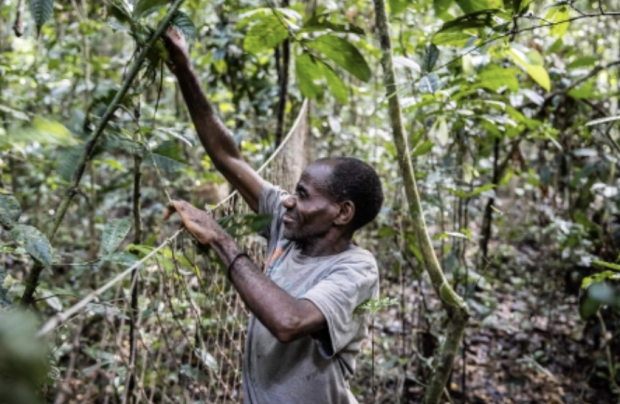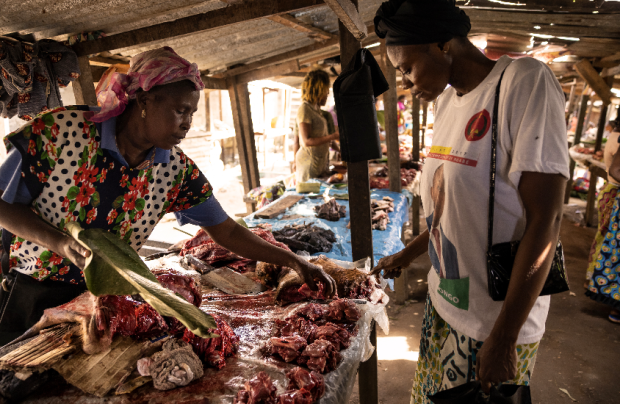In the Congo Basin, the bushmeat trade threatens the health of people and forests.
Discussion details
It’s a long way from the busy markets and restaurants of Brazzaville to the remote Nouama Ndoki national park in the far north of the Republic of Congo (ROC). But the 1000 km boat ride or the 12 hour road trip is no obstacle to a booming illegal bushmeat trade which threatens not only the wildlife but the health of the people that live there.

Brazzaville, and its twin capital city Kinshasa on the opposite bank of the Congo, is home to an urban middle class keen to keep up the traditions of their parents and grandparents. That means eating bushmeat, especially since its price is attractive, a kilo of antelope remains cheaper than a kilo of beef. Laws in both contries distinguish between hunting for subsistence and hunting for income - but the increasing demand from urban customers is jeopardising the ability of wild populations to regenerate. It is estimated that up to 10,000 bushmeat dishes are served every day in restaurants across both cities, which have a combined population of 17 million. That’s bad news for remote rural communities in both ROC and the Democratic Republic of Congo (DRC) which rely on sustainable hunting to survive.
“Lately, we are only catching animals by chance. They are now hiding far away,’’ says Thomas Aseli, a member of the Mbuti people who live in the Ituri forest near DRC’s border with Uganda. “There are now too many people in the forest, but I live there. I don't want others to come and destroy it.”

The future of the Mbuti and other indigenous peoples depends on a healthy ecosystem which can support sustainable hunting, but according to the EU-funded Sustainable Wildlife Management (SWM) programme, the forests of the Congo Basin are being depleted at an alarming rate by the bushmeat trade, driven by demand from city dwellers.
The recently-signed Forest Partnership between the EU and Republic of Congo aims to ensure local communities and indigenous people are involved in protecting, restoring and managing forests sustainably.
“By hunting, we have just enough to eat. We can survive with the few animals that we catch and we sell a few as well,” adds Thomas. “This is how we live, but the money we get from one duiker [small antelope] is not enough for the whole family.” Thomas’ story is all too familiar. “Hunters on the ground tell me there are far fewer animals than there used to be,” says photo-journalist Brent Stirton, who spent time with SWM and the Baka pygmy bushmeat hunters who live on the edge of the Nouama Ndoki national park. “What used to take half an hour to hunt now takes two days, and as a result the value of the bushmeat has sky-rocketed.”

The UN Food and Agriculture Organisation (FAO) - who run the SWM programme - commissioned Stirton to document the bushmeat trade across the Congo Basin from sustainable hunting to industrial-scale slaughter. “I met a man on a barge coming down the Congo from Équateur to Kinshasa,” he recalls. “He had nearly 160 dead monkeys with him - that’s what he and his wife shoot every two weeks. He makes about US$4,500 a month, more than most Americans. That’s two people with two shotguns - multiply that by the thousands of people involved and you end up with millions of tonnes of animals.”
Data from the Centre of International Forestry Research (CIFOR) suggests people eat an estimated five million tonnes of bushmeat per year in the Congo Basin. “The Congo Basin is the greatest repository for bushmeat in the world, but the combination of extractive industries and the impact of bushmeat hunting just does not allow animal populations to recover in time,” adds Stirton.
Sustainable hunting not only gives indigenous people a valuable source of food, but is vital for their health and wellbeing. Studies have shown that Baka forced to leave the forest and live in villages demonstrate a marked decline in their physical and mental health. “They are always worse off than those who stay in the forest,” says Julia Fa, a senior associate scientist with CIFOR - one of the SWM partner organisations. “Nutritionally, they are much deprived. A massive influx of logging labourers and an expansion of the wild meat trade has endangered some wildlife species, adding a further threat to Baka livelihoods.”

But the health implications of the global bushmeat trade go way beyond food security and nutrition. The recent Covid-19 pandemic was a forceful reminder that eating wild meat can have devastating consequences. “I see a lot of human suffering in this as well,” says Stirton, who spent two years in investigating the links between wild meat and disease in 11 countries. “I did a lot of work on bats, on civets, on pangolins and I went to a lot of wet markets in Indonesia and China. The implications of infectious zoonotic diseases (animal to human) or reverse zoonotic diseases (human to animal) are underreported - we don’t talk enough about that. Bushmeat is an economic issue for people’s livelihoods, it’s a sustainability issue for ecosystems and animals, and it’s a disease issue in terms of pandemics. So it’s a really multi-tiered problem.”
In northern Congo, SWM is working with the Wildlife Conservation Society (WCS) to help Baka hunters maintain their way of life through sustainable hunting. For example, workers in logging concession are allowed to hunt or to hire Baka to hunt for them twice a month in a legal hunting area on the edge of Nouama Ndoki National Park. “Each hunter gets a rifle and four shotgun cartridges,” he explains. “They are only allowed to shoot that much, no more.” Legal, sustainable hunting totally prohibits the slaughter of protected or fully protected species, such as gorillas or forest elephants. Those caught risk incurring a heavy fine.
Located in the heart of the Trinational Sangha the SWM projects covers the Nouabalé N’doki Park and its peripheral FSC-certified forestry concessions. The area area is home to at least 116 species of mammals, including the critically-endangered western lowland gorillas, as well as hundreds of species of birds, reptiles and fish. Among the initiatives aiming to encourage local people to eat less bushmeat,are the promotion of sustainable, healthy alternative sources of protein such as poultry, whilst allowing indigenous communities such as the Baka to continue with their traditional way of life.

Outbreaks of the Ebola virus in the Congo Basin in recent years underline the risks posed by bushmeat. According to the US Centers for Disease Control and Prevention (CDC) Ebola infections in central Africa have been associated with hunting, butchering, and processing meat from infected animals. “By butchering an animal that has been infected, because Ebola is transmitted by contact, they get infected themselves,” says Dr Robert Nasi of CIFOR. Other deadly diseases associated with eating or handling bushmeat include SARS, monkeypox, Marburg virus and HIV. “We are losing the building blocks of the ecosystem,” reflects Stirton, who won the photojournalism category at the 2022 Wildlife Photographer of the Year Awards. “It’s so short sighted, so short term. It’s get what you can, while you can. I have a five year old son and I would really like him to see the world as I have been fortunate enough to see it, but I worry that I’ll come back to the Congo Basin in ten years and there will be nothing left. For me, the silent forest syndrome is real, I’ve seen it personally.”
Photos:
© Brent Stirton/Getty Images for FAO, CIRAD, CIFOR, WCS
© FAO/Thomas Nicolon
Log in with your EU Login account to post or comment on the platform.